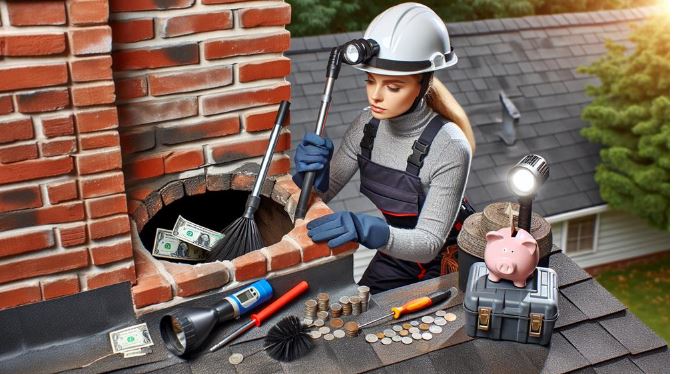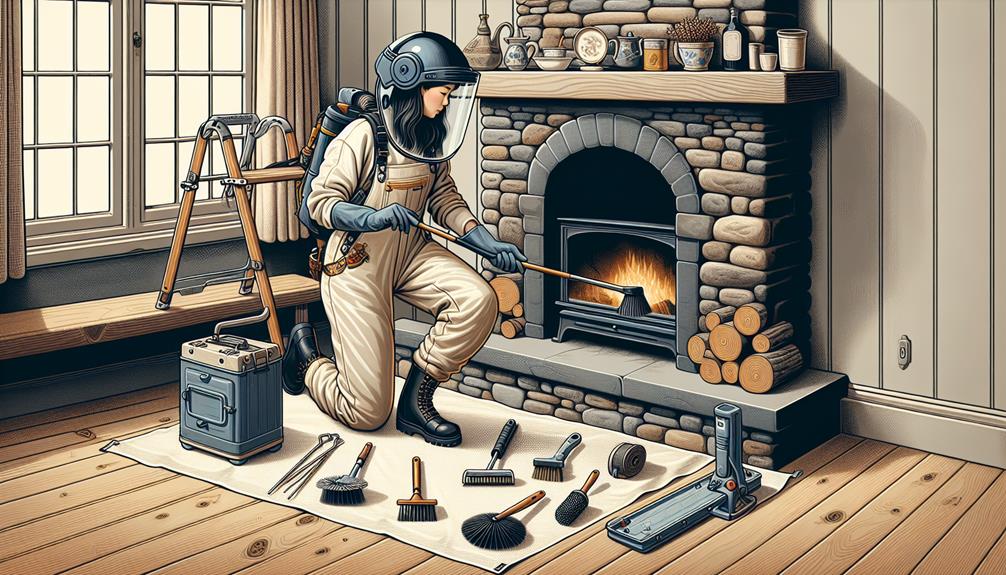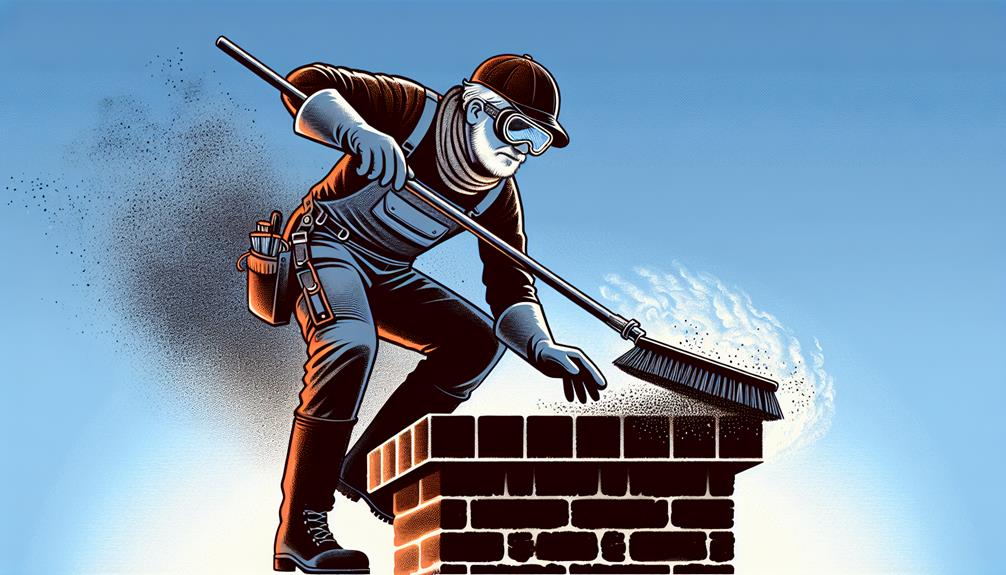Chimney sweeps play a crucial role in maintaining the safety of buildings by removing dangerous creosote buildup and blockages from chimneys.
Regular chimney cleaning not only reduces the risk of fires but also ensures proper ventilation, which is essential for the efficient operation of heating appliances.
By keeping chimneys clean, chimney sweeps help protect both property and lives.
Responsibilities of a Chimney Sweep
When working as a chimney sweep, your main job is to check and clean fireplaces, chimneys, and flue pipes to keep them safe and working well. Chimney sweeps are trained to find things like creosote buildup or blockages that could cause chimney fires. Safety is super important because a dirty chimney can be really dangerous for a home. By regularly cleaning chimneys, chimney sweeps help prevent problems and make sure the fireplace works correctly.
Chimney sweeps need to pay close attention to detail to catch any issues that could make the chimney unsafe. They use special tools like metal brushes to scrub away dirt and make sure the chimney is clean and clear. Besides cleaning, chimney sweeps may offer treatments to deeply clean the chimney and do small repairs to keep it in good shape. After cleaning, they give a report on the chimney’s condition so homeowners know about any potential issues that need fixing.
Chimney Cleaning Techniques
Chimney sweeps use metal-bristled brushes to clean chimneys. These brushes scrub away debris, gunk, and creosote buildup. They clean from the top down or bottom up to remove the flammable creosote.
Chimney sweeps also offer chemical treatments to break down deposits for easier removal. They do minor repairs and use drop cloths and vacuums to keep the area clean. Regular cleaning prevents chimney fires and keeps fireplace use safe.
Importance of Chimney Inspections
Regular chimney inspections are crucial for keeping your fireplace safe and working well. These inspections help check for dangers like creosote buildup and blockages that can cause fires.
Professionals look for issues like leaks, structural problems, and proper airflow to prevent costly damage. Following safety standards, annual inspections recommended by the Chimney Safety Institute of America ensure your chimney is safe to use.
Tools Used by Chimney Sweeps
Chimney sweeps use special tools to clean chimneys effectively.
They use a big brush with metal bristles to remove soot and creosote buildup from the walls.
They also use drop cloths to keep the area clean and shop vacuums to suck up debris and soot from the chimney and fireplace.
Hazards Identified During Inspections
During chimney inspections, chimney sweeps often find dangerous things that can make chimneys unsafe. They see creosote buildup, which is a flammable residue from burning wood. This can start fires if not cleaned out.
They also find blockages like nests, debris, or damage that can stop air from flowing properly, causing smoke to come back into the house. They check for cracks or damage in the chimney lining that can lead to leaks or exposure to harmful gases like carbon monoxide.
They also look for animals or pests living in the chimney, which can block air and make people sick. Lastly, they watch out for water damage or moisture problems that can weaken the chimney over time.
Repair Services Offered by Sweeps
Chimney sweeps provide important services to keep your chimney safe and working properly. They fix chimney caps, liners, and flue pipes, as well as clear blockages and leaks. Sweepers can also handle bigger repairs like rebuilding or relining chimneys.
Installation Assistance is provided.
Chimney sweeps help install chimney liners, caps, and dampers for better chimney performance and safety. They make sure these parts fit properly and are positioned correctly during installation. Chimney sweeps also assist in choosing the right materials to improve chimney efficiency. Their expertise in installation is crucial for a safer and more effective chimney system.
Advice on Chimney Maintenance
To keep your chimney safe and working well, it is advisable to seek advice from a professional chimney sweep. They specialize in cleaning fireplaces, chimneys, and pipes to prevent fires and reduce the risk of carbon monoxide exposure. Chimney sweeps utilize specialized tools such as brushes and vacuums to effectively remove dirt, enhancing the efficiency of your fireplace and potentially saving you money on energy costs.
In addition to cleaning services, chimney sweeps may recommend chemical treatments for deep cleaning and can address minor issues before they escalate. By scheduling regular maintenance with a chimney sweep, you can ensure that your chimney remains safe and operates efficiently, ultimately contributing to a safer environment in your home.
Don’t wait until problems arise; book an appointment with a chimney sweep today to proactively maintain the safety and functionality of your chimney.
Fire Prevention Measures
To keep your fireplace safe and prevent dangers, it’s important to take steps to avoid fires. One crucial action is to clean your chimney regularly to remove creosote, which can cause chimney fires. Make sure to have your chimney inspected at least once a year to check for any blockages or issues.
Chimney fires are serious, so it’s best to be proactive. Hiring a professional chimney sweep to clean and inspect your chimney can greatly reduce the risk of a fire. These experts not only clean but also spot any potential fire hazards.
Improving Indoor Air Quality
Regular chimney sweeping is important for keeping the air inside your home clean and healthy. When chimneys aren’t cleaned often, harmful substances like creosote and soot can build up. These pollutants can enter your home and make the air dirty, which can cause breathing problems. By cleaning your chimney regularly, you can remove these contaminants and improve the air quality inside your home.
Here are some benefits of chimney sweeping for indoor air quality:
- Removing Contaminants: Getting rid of creosote, soot, and debris that can make indoor air dirty.
- Preventing Health Issues: Reducing respiratory problems and allergies that can be caused by poor air quality.
- Enhancing Ventilation: Making sure air can flow properly and lowering the risk of carbon monoxide exposure.
- Eliminating Odors and Allergens: Getting rid of bad smells and allergens makes your home healthier.
Following the recommendation of the Fire Protection Association (NFPA) for regular chimney sweeping can help you maintain good indoor air quality and create a healthier living environment.
Training and Certification Requirements
Chimney sweepers need training and certification to clean chimneys properly and ensure clean indoor air. They learn about chimney systems, safety rules, and maintenance in training programs. Getting certified, like with CSIA, shows they know their stuff.
Chimney sweeps keep learning to stay updated and follow the best practices. Certification proves their professionalism and guarantees good service for customers. With training and certification, chimney sweepers can improve their skills, keep things safe, and give homeowners top-notch chimney cleaning.
Cost of Chimney Sweep Services
When you need a chimney sweep, it’s good to know the usual costs. Prices typically range from $75 to $250. If your chimney is in bad shape, you might have to pay more. For instance, if there are major repairs needed, the cost could go over $1,000.
Structural problems or pests can also make the service more expensive. Extra services, like dealing with pests or fixing big issues, may come with additional charges. It’s best to have a professional check your chimney to give you an accurate estimate.
Here’s a breakdown of potential costs for chimney sweep services:
- Standard Sweep: $75 – $250
- Minor Repairs: $100 – $500
- Major Repairs: $500 – $1,000+
- Pest Infestation Removal: $150 – $300+
Frequently Asked Questions
How Do You Know if Your Chimney Needs Sweeping?
If you see more than 1/8 inch of soot or glaze in your chimney, it needs cleaning. Even a small 1/8-inch buildup can lead to chimney fires. Remember to check every year for safety. Follow the CSIA guidelines and take action promptly if you find creosote glaze.
How Often Should You Sweep Your Chimney?
You need to clean your chimney once a year to stay safe. Even a little bit of soot can start a fire. It’s important to keep your chimney clean to prevent fires and protect your home.
What Does a Chimney Sweep Actually Do?
A chimney sweep inspects, cleans, and maintains fireplaces and chimneys using special tools. They remove debris, creosote, and blockages to keep the chimney safe. They also provide detailed reports about the chimney’s condition.
Does a chimney sweep make a mess?
Yes, a chimney sweep can make a mess during cleaning. They use drop cloths and vacuums to clean up debris and soot, leaving the area clean.
Conclusion
In simple terms, a chimney sweep is like a guardian for your chimney. They make sure it stays safe and works well.
Just like how a lighthouse helps ships find their way, a chimney sweep clears out any dangers in your chimney.
So, when you hear them working, remember they’re the heroes keeping your home cozy and safe.











